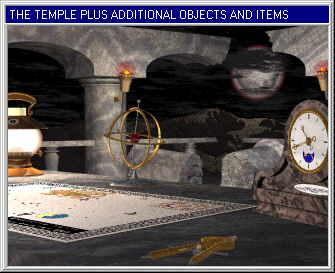

|
|
|---|
|
More primitives
· Until this point, we used the temple to demonstrate the usage of some simple shapes. But now we are going to make a real scene out of it! 
· This implies not only the usage of additional POVLAB- objects and -functions but also topics like »scene- illumination/advanced light-settings«, »gimmicks with textures« and »setting up camera- parameters«. To get a quick overview of what's coming up, check out the picture above and the items, that have been added. · Let's see what we have got: obviously the temple has become the home of an astronomer or some sort of scientist. In detail we have to model the following items: »a Table«, »a Globe« (or is it a gyroscope - anyway), »a Grandfather-Clock«, »a Pair Of Circles«, »a Lamp«, »a Torch« and »a Starmap«. · Besides this we can also see a moon, clouds, stars (though these are a bit dark), a mountain and some peculiar light-effects. These items are all covered in one of the upcoming sections, when we take a close look at »textures and texture-parameters« |
Attention:
· Some of the things, we are going to model will be quite complex and therefore it will not always be possible to write down all the coordinates, scaling-vectors and so on. But there's no need to panic: all objects we're going to discuss can be downloaded as regular POVLAB-scenes. You can study or use these scene-files in your creations for no charge, as long as it is for non-commercial purposes only. A list of all downloadable scene-files will be included in this tutorial soon. The Globe · The item we will begin with is the »medieval globe«, since it is relatively simple.
· In the next step, we'll encounter the first new object, though this will not be very exciting. It's a ring, that we will place right in the middle of the torus to get some details onto the object. A ring is handled nearly the same way as a torus. That means: select the viewport you are going to work in and then draw the ring, determining the outer and inner radius with the mouse. For the globe, we need an outer radius of »[3.2]« (ca.) and an inner radius of »[2.75]« (ca.). Let's make it simple: determine the size of the ring, so that it meets your sense of proportion. |
| Chapter B/Page 7 |
|
Mail to webmaster:
support@povlab.org This page was last modified on: 1996-07-28 |
Mail to the author of the POVLAB-Tutorial:
lepschi@source.co.at |